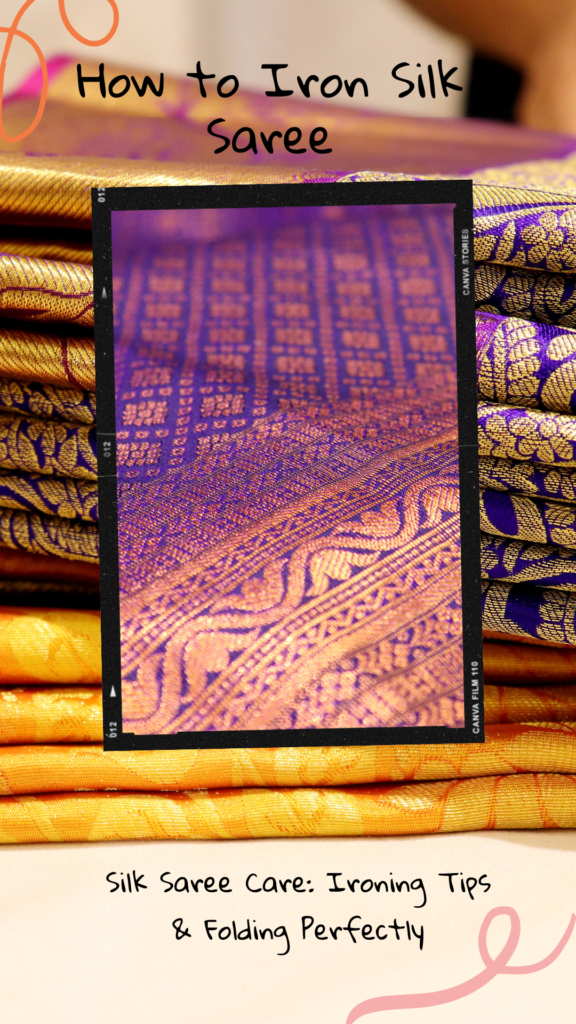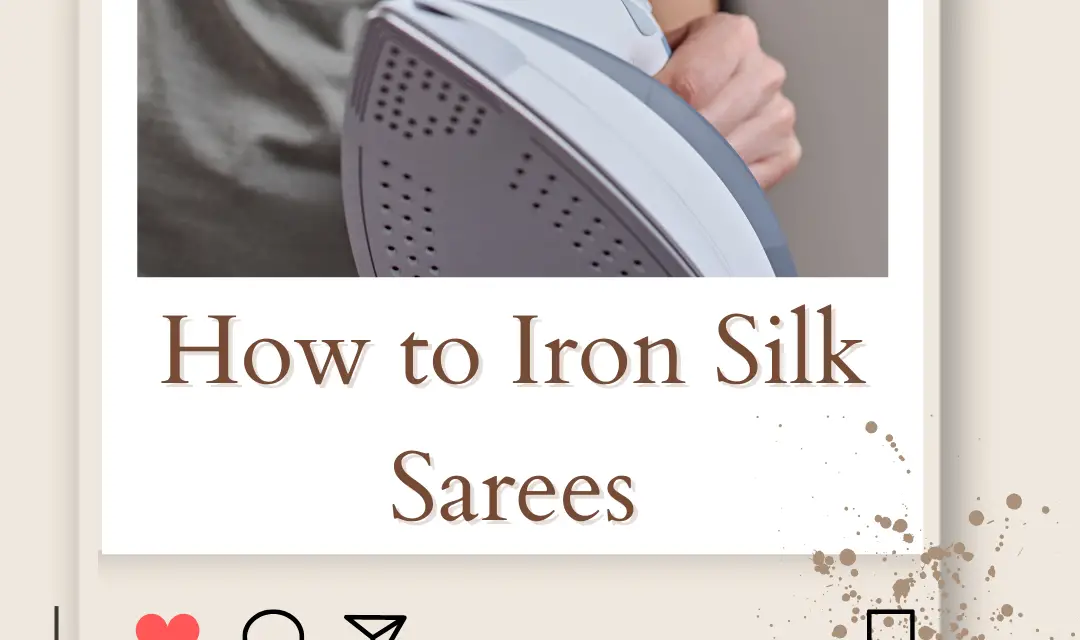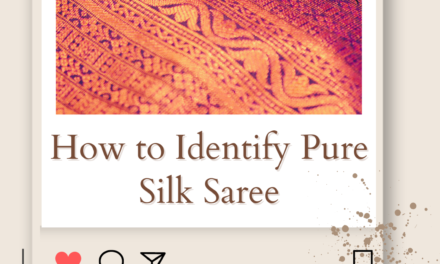How to iron silk sarees at home? Silk sarees are renowned for their exquisite beauty and luxurious texture. To ensure that they retain their allure, proper care is essential, especially when it comes to ironing, also known as pressing.
Note: Wash your silk saree properly before ironing, it also applies to any type of saree fabric as well.
How to Iron Silk Sarees at Home?
The Importance of Proper Ironing for Silk Sarees: Silk is a delicate fabric that requires gentle handling, and ironing plays a crucial role in maintaining its flawless appearance.

Here’s why it is important to use the proper temperature and technique when ironing silk sarees:
- Preventing Damage: Excessive heat or improper ironing techniques can damage the silk fibers, leading to irreparable harm such as scorch marks or fabric weakening. By using the correct temperature and approach, you can protect the integrity of the silk.
- Preserving Luster: Silk sarees have a natural sheen that adds to their beauty. Proper ironing helps to revive and enhance this luster, giving your saree a fresh and polished look.
Note: Different silk fabrics have varying heat resistance and may require different ironing temperatures to avoid damage, refer to the below table.
Ironing Temperatures for Different Types of Silk Fabrics
| Silk Fabric | Recommended Ironing Temperature (°C) |
|---|---|
| Mulberry | 110-130 |
| Tussar | 110-130 |
| Chiffon | 110-120 |
| Organza | 110-120 |
| Raw | 120-130 |
| Crepe | 120-130 |
| Satin | 110-120 |
| Georgette | 110-120 |
| Dupion | 130-150 |
| Velvet | 110-120 |
| Matka | 130-150 |
| Pashmina | 110-130 |
| Banarasi | 110-130 |
| Kanjivaram | 110-130 |
| Mysore | 110-130 |
Steam Settings for Ironing Different Types of Silk Sarees
| Silk Saree Type | Steam Setting |
|---|---|
| Mulberry | Low to Medium |
| Tussar | Low to Medium |
| Chiffon | Low to Medium |
| Organza | Low to Medium |
| Raw | Low to Medium |
| Crepe | Low to Medium |
| Satin | Low to Medium |
| Georgette | Low to Medium |
| Dupion | Medium to High |
| Velvet | Low to Medium |
| Matka | Medium to High |
| Pashmina | Low to Medium |
| Banarasi | Low to Medium |
| Kanjivaram | Low to Medium |
| Mysore | Low to Medium |
Fahrenheit and degrees Celsius for different fabrics
| Fabric | Temperature Setting (°F) | Temperature Setting (°C) |
|---|---|---|
| Wool | 110 | 43 |
| Silk | 160-180 | 71-82 |
| Linen | 200-220 | 93-104 |
| Cotton | 220-240 | 104-115 |
Please note: that these temperature ranges are still approximate and may vary depending on the specific silk fabric, the thickness of the saree, and personal preferences.
Steps to Iron Silk Saree
- Prepare the saree: Remove any pins or clips from the saree and lay it flat on an ironing board.
- Place a cotton cloth: To protect the silk from direct heat, place a clean cotton cloth over the saree before ironing. This acts as a barrier and prevents any damage.
- Set the iron temperature: For silk sarees, it is recommended to set the iron to a low to medium temperature. If you are unsure, perform a test on a small, inconspicuous area of the saree first.
- Iron the saree: Start by ironing the hem of the saree, then gradually move to the body, working from the top down. Maintain a light touch to prevent unnecessary pressure on the silk fabric.
- Fold the saree: Once the saree is ironed, fold it according to your preference, ensuring that it is cool before folding to prevent any creases.
Tips for Ironing Silk Saree
- Use a steam iron: A steam iron can be beneficial for silk sarees as the steam helps to relax the fabric and minimize wrinkles. However, ensure that the iron is not too close to the fabric to avoid any moisture damage.
- Iron on a cotton cloth: Placing a cotton cloth between the iron and the silk saree provides an additional layer of protection and helps to evenly distribute heat.
- Iron in sections: Divide the saree into manageable sections and iron each passage carefully, ensuring that you cover the entire fabric.
- Avoid excessive pressure: Silk is delicate, so avoid pressing too hard while ironing. A gentle touch is sufficient to remove wrinkles.
- Let it cool: Allow the saree to cool completely before folding it. This helps to set the fabric and prevent new wrinkles from forming.
Conclusion: By following the proper ironing techniques outlined above, you can maintain the pristine beauty of your silk sarees. Remember to use the correct temperature, protect the fabric with a cotton cloth, and iron with a light touch.
With practice, you will become adept at ironing silk sarees, ensuring they always look their best. By taking the time to care for your silk sarees, you can enjoy their elegance and grace for years to come.
FAQs on Ironing Silk
Can I iron a silk saree directly without using a cotton cloth?
It is not recommended to iron a silk saree directly without a protective barrier. Using a clean cotton cloth over the saree helps to prevent direct heat contact and potential damage to the delicate silk fabric.
What temperature should I set the iron to when ironing a silk saree?
It is best to set the iron to a low to medium temperature for silk sarees. However, it is advisable to perform a temperature test on a small, inconspicuous area of the saree first to ensure it is suitable and doesn’t cause any damage.
Can I use a steam iron for ironing silk sarees?
Yes, a steam iron can be used for ironing silk sarees. The steam helps to relax the fabric and minimize wrinkles. However, make sure the iron is not too close to the fabric to avoid any moisture damage.
How should I iron the silk saree to avoid damaging the fabric?
To avoid damaging the silk fabric, start by ironing the hem of the saree and then proceed to the body, working from the top down. Use a light touch and avoid applying excessive pressure while ironing to prevent any potential damage.
Can I fold the silk saree immediately after ironing?
It is recommended to let the silk saree cool completely before folding it. Allowing the fabric to cool helps to set the shape and prevents new wrinkles from forming.
What should I do if I accidentally burn or scorch my silk saree while ironing?
If you accidentally burn or scorch your silk saree, it is challenging to repair the damage. Prevention is key, so always be cautious with the iron’s temperature and avoid excessive heat or prolonged contact with the fabric.
Can I use a dry cleaning service to iron my silk sarees?
Dry cleaning services can be used to professionally clean silk sarees, but it is recommended to discuss ironing requirements with the dry cleaner beforehand. Some dry cleaners may offer ironing services, while others may prefer not to iron delicate fabrics like silk sarees.
How often should I iron my silk saree?
The frequency of ironing depends on how often you wear and store your silk sarees. Ideally, iron them before each use to ensure a wrinkle-free appearance. However, avoid excessive ironing as it may weaken the fabric over time.















